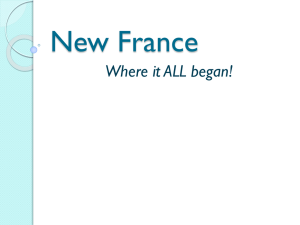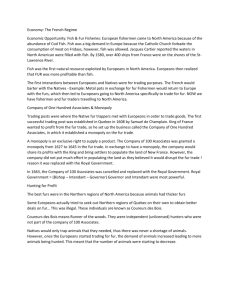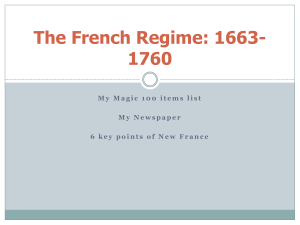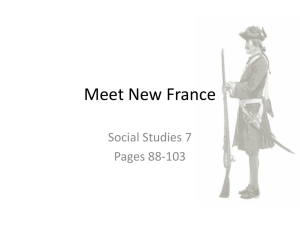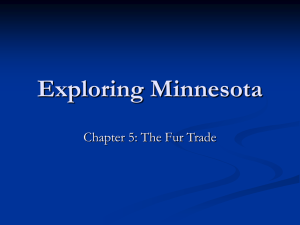New France-Powerpoint economy edit
advertisement
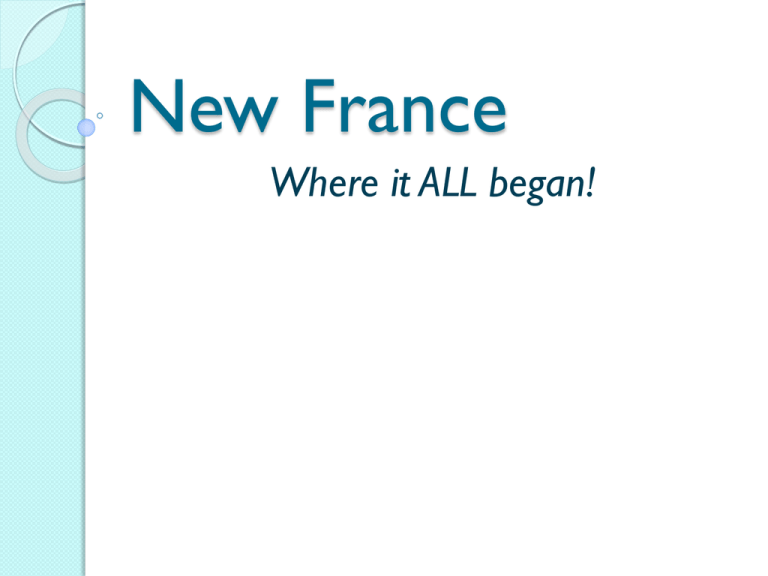
New France Where it ALL began! What questions will we answer? 1) Why did France decide to settle along the St. Lawrence River? 2) What kind of society did New France have? 3) What were the relationships between the First Nations and the French fur traders like? How was this different than the English fur traders? 4)Who won the Battle of the Plains of Abraham, and why was this important? Question #1: Why did France decide to settle along the St. Lawrence River? There were a couple of reasons... Reason #1: GOLD AND RICHES Jacques Cartier: explorer In 1534, Jacques Cartier was sent by the King of France to find two things: a shipping route to China, and gems and gold to make France rich. He explored the mouth of the St. Lawrence River, but in the winter of 1535, his ship was trapped in ice and almost all of the 110 crewmen became sick with scurvy! 1541: Cartier returned to France with what he thought were diamonds, but they were actually just quartz. Cartier’s Travel Routes Samuel de Champlain: Explorer Samuel de Champlain explored North America between 1603 and 1635. He was a CARTOGRAPHER, meaning he was trained in map drawing, which helped others to follow his voyages. Samuel de Champlain founded (created) a settlement at Quebec City. It took him 20 years to build enough buildings and bring enough settlers to make it work. ◦ Many of the settlers were soldiers who came to protect the settlement, and decided to stay Reason #1: Gold and riches? Neither Cartier nor Champlain actually found gold and riches, but they DID encourage settlement in the areas along the St. Lawrence River. Reason #2: Religion France was mainly a Catholic empire. If you were not Catholic, you were not welcomed. Many people in France wanted to make sure that New France would be Catholic too, so they came and settled in the colony. Jesuit Priests Some of the men who left France in 1611, were known as Jesuit Priests. They had two goals: ◦ 1) spread religion to the First Nations ◦ 2) establish schools for boys in New France 1634: they built Sainte-Marie Among the Hurons, as a place where they could teach and worship in peace. 1648: it was attacked by Iroquoian warriors and 6 priests were killed. 1649: The priests abandoned the site, because it was unsafe. Ursuline Nuns A group of devoted women who taught reading, writing, arithmetic and homemaking in New France. They worked to prepare young women for either motherhood or for joining the church. This group still exists and they do many religious and charitable work throughout Canada. Reason #2: Religion? Jesuit Priests and Ursuline Nuns settled along the shores of the St. Lawrence River so that they could share their religion with the First Nations, and help to educate the people of New France. Reason #3: Fur In the 1600s, fur was greatly valued ($$). As settlers in New France began to trade with First Nations, they began to collect more and more, top quality furs. The fur trade was very regulated, until 1663 when king Louis XIV of France declared anyone could trade or trap for fur. Traders would exchange hatches, metal pots, and other supplies for furs with the First Nations. Enter… the COUREURS de BOIS Coureur de bois left the colony of New France to trade with trappers in the ‘back-country’. These men operated ILLEGALLY, and had to be very careful. 1670s, there were between 300-400 of them. Unfortunately, they collected more fur than was needed. 1696, King Louis XIV put an end to the free-trade, and ended the success of the Coureur de bois. Reason #3: Fur? There was a great demand for fur in France, and because there was an abundance of fur in New France, people wanted to settle there to begin trading. Reason #4: FARMS Most newcomers to New France were farmers. There were two groups: 1) Seigneurs 2) Habitants 1) Seigneurs These were men who had won the king’s favour and were in charge of a large area of land, called a seigneurie. Seigneuries were long areas of land, along the main waterways. These were divided up into smaller pieces and farms. A seigneur could keep a portion for himself, but he had to get farm families (HABITANTS) to settle on the rest of it 2) Habitants These were farming families who worked hard to maintain the land. They would grow crops and raise animals, but they had to share a portion of their crop with the seigneur. They also worked for 10 days a year without pay for the seigneur, and they had to pay taxes to the church and government. Filles du Roi There was one major problem in New France: there were not enough SINGLE WOMEN!! The King imported young women to New France, many of whom were orphans with no family. ◦ They were given free transport, settlement expenses and a dowry ($$). ◦ Filles du Roi helped develop New France by providing stable families. Reason #4: FARMS? There was good farm land in New France along the St. Lawrence, so many seigneurs and habitants decided to settle there. Filles du Roi helped to farm the land and to settle the colony itself. Why did France decide to settle along the St. Lawrence River? 4 Reasons There could be riches and gold To make sure New France would be a Catholic community. There were lots of good furs There was very good farmland Question #2: What kind of society did New France have? New France was a HIERARCHIAL society Society: community Hierarchy: a society in which there are distinct levels that are all fairly separate Like the School System! Teachers Students Principals Minister of Education School Board Superintendents New France had two Hierarchies A) Civil Hierarchy: everyday people B) Religious Hierarchy: the Church a) Civil Hierarchy –everyday people A hierarchy of general citizens This structure was the same in both France and New France KEY POINT: There were NO elections! ◦ Everyone was selected for their role. Viceroy: person who runs colony on behalf of king/queen Sovereign Council: made rules and laws about day-to-day things in colony Governor: appointed members to council Intendant: made sure rules and laws were obeyed The Government - Key person in the government was the GOVERNOR He was a symbol of the King and was expected to act a bit like one - He had big parties and dances for the top people in New France and he travelled around the colony each summer. - The governor was also responsible for relationships between New France and other European countries. Louis de Buade. COUNT FRONTENAC He was one of the most famous governors King Louis XIV sent him to make sure New France stayed close to trade routes with France He was supposed to develop the seigneuries; NOT the fur trade because it would upset the British and Dutch to the south But He Ignored His Orders! Count Frontenac saw the fur industry as an opportunity to make himself rich He sent out military parties to explore the region for more fur, and to build forts to defend the colony Frontenac’s push for fur caused First Nations to fight amongst themselves ◦ The Iroquois had supplied the Dutch, and soon began to fight with the Huron, Illinois and Abenaki peoples King Louis XIV was angry that Frontenac had ignored him, and so called him back to France in 1682. However, Frontenac was able to persuade Louis XIV to send him back to New France. Frontenac continued to profit from the fur trade, and by the late 1690s had out-lived his favour with the King. He was recalled to France, but died suddenly in 1698. B) Religious Hierarchy: The Church In the beginning, all of the CLERGY came from France ◦ Clergy: people trained to lead religious groups Once New France was really established, the Church began to build its own local organization Bishop The Clergy Lay Organizations The Bishop: a high ranking Church official usually in charge of a district Francois de Laval: arrived in New France in 1659 He was given the job of organizing all aspects of the Church’s work in the colony In 1674, he was appointed first bishop of New France In 1663, de Laval set up the Seminary school of Quebec, which was to train men for priesthood The Clergy: group of people involved with the Church Once Laval was appointed as bishop of Quebec, he could divide the area into parishes ◦ Parish: area served by a local church Priests were able to expand the influence of the Church as the population of the colony increased This is how the Roman Catholic Church became a key influence throughout New France Lay Organizations: religious organizations run by people who are not clergy These groups helped extend the influence of the Church, by providing opportunities for working, learning and participation in the life of New France. They brought the church into everyday life! The Citizens of New France Read pages H34- H37 Answer the questions on the handout IN FULL SENTENCES Submit when done. The Economy of New France New France was a colony which meant it was not an independent entity. It belonged to the mother country A colony’s main job is to support the mother country and provided it with riches. Economy cont’d 2 main goals: 1. Provide new raw materials for France 2. Provide useful markets for goods produced in the mother country eg. Cloth, hardware. Economy cont’d What is mercantilism? - New France provided France with the raw materials and then sent them to France where they became manufactured goods. France then sold the manufactured goods back to the colony. - This system made the colonies a profitable economic enterprise. Advantages and Disadvantages to Mercantilism Advantage: -produced wealth and consumed goods for the mother country Disadvantage: - the development of the colony was always in the interest of the mother country and not the colony. Trade with other places was forbidden Triangular Trade North Atlantic Triangle New France France Manufactured goods Furs wood, Fish Sugar Rum Tobacco Fish Flour Wood Manufactured Goods Sugar, rum, tobacco Antilles The Economy Of New France Let’s Work Together! ◦ Read pgs H38-H 41 as a class ◦ Using the organizer provided, pick out the key points and words from each section QUESTION: Why did New France not really make France as rich as Champlain hoped it might? 2) What kind of society did New France have? Hierarchial society ◦ Civil and Religious ◦ Governor and Bishop were very important ◦ Citizens all had specific roles The Economy was fairly strong - based around MERCHANTILISM - set up as TRIANGULAR TRADE - ‘Fish and Furs’ economy Assignment: A Letter from a New France Citizen Imagine you are a settler in New France around 1700. ◦ Write a letter to relatives in France, telling them what your life is like and what it is like to live in New France. ◦ Include: Your trade or role in the colony Age, male/female Some everyday things you may do At least 3 key terms/ people we have learned about Category Guiding Questions Knowledge/Understanding - key terms, events, names, used correctly - Did I look up the names key terms from my notes? How do I know they are right? Did I follow a proper letter structure? Thinking - letter is original - makes connections between character’s position in the society and how he/she would experience everyday life What connections have I made between what I know about New France and what I think it would be like to live there? Have I written from the perspective of someone living in New France in the 1700s? Application - follows instructions to finish - includes all MUST HAVEs from list - final product is visually pleasing Did I follow all the instructions from start to finish? So I have all the MUST HAVEs from the list? Did I get creative with my final product? Is it ‘pretty’? Communication - little or NO spelling or grammatical errors Did I, a peer, or an adult, edit my work for spelling or grammatical errors? Do I understand what I have written? Level/ Comments 4 3 2 1 Question #3 What were the relationships between the First Nations and the French fur traders like? How was this different than the English fur traders? Working in Groups Read “The French and the First Nations Peoples”, pgs H46-H 49. Gathering key points and information, come up with an answer for the key question: ◦ What were the relationships between the First Nations and the French fur traders like? How was this different than the English fur traders? Write points on the paper provided to be displayed in the classroom! Question #4 Who won the Battle of the Plains of Abraham, and why was this important? SHOW VIDEO with QUESTIONS REVIEW DAY! Whoop Whoop! YOUR jobs for today, include: 1) Finish any OUTSTANDING assignments or Tasks!! 2) Start making study notes USING the LOVERLY review sheet I gave you before the break. ◦ You can work QUIETLY with a partner, if need be!

